 |
GOVERNOR ROCKEFELLER DRIVES FIRST PILE
FOR OBSERVATION TOWER OF HOST STATE'S EXHIBIT
|
|
Governor Nelson D. Rockefeller drove the
first pile in the 200-foot high observation tower of the New
York State pavilion from which millions will have a sweeping
view of the Fair's 646-acre site.
At the ceremonies held on October 9th,
Lieutenant Governor Malcolm Wilson, who is chairman of the New
York State Commission on the World's Fair, also revealed for
the first time plans for the state's $5,000,000 installation.
|
|
| Governor Nelson D. Rockefeller drives the
first pile in the 200-foot high observation tower of the New
York State pavilion. Left to right: President of the Fair Robert
Moses, Mrs. Paul Peabody, Lt. Gov. Malcolm Wilson, Judge John
Lomenzo, and Governor Rockefeller |
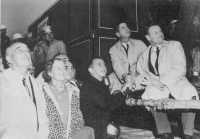 |
|
|
Conceived as the "County Fair of the
Future," the installation will combine the activity and
the excitement of the traditional local fair with a dramatic
and unique architectural treatment that envisions a world of
tomorrow.
Consisting of three principal structures,
the exhibit will include a theatre, a "Tent of Tomorrow,"
three observation towers, the tallest of which will be the highest
point in the World's Fair grounds.
The "Tent of Tomorrow" will be
the heart of the state exhibit. An elliptical shaped, 350-foot
by 250-foot structure, whose outer support will be sixteen 100-foot
tall, white concrete columns, the Tent will feature the world's
largest suspension roof.
At the groundbreaking ceremony which was
attended by various members of the New York State World's Fair
Commission, Robert Moses, president of the Fair, greeted Governor
Rockefeller and Lieutenant Governor Wilson and presented them
with silver World's Fair Souvenir Medallions.
Following the presentation, governor Rockefeller,
Lieutenant Governor Wilson, Mr. Moses and other members of the
official group proceeded to the state's site where the three
officials spoke briefly to the assembled workers and guests.
Governor Rockefeller then tripped a valve, activating the pile
driver, and the Fair's tallest structure was underway.
The Thompson-Starrett Construction company
is building the "County Fair of the Future," which
was designed by Philip Johnson.
|
|
| Architect's rendering of the New York State
pavilion being built at Flushing Meadow for the New York World's
Fair, showing the theatre (circular building on lower left),
the flag-bedecked "Tent of Tomorrow" and the three
observation towers. |
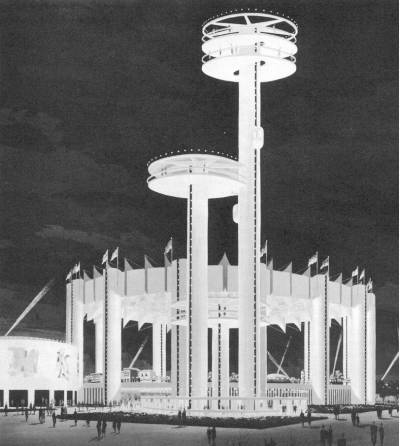 |
- Source: FAIR NEWS Official
Bulletin of the New York World's Fair 1964/1965
- Source: Vol. 1, No. 5 - October 16, 1962
|
|
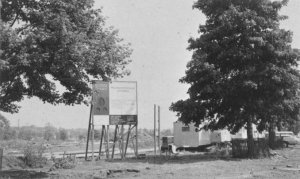 |
Construction on New York State Pavilion
Progress Report #6, September 12, 1962
|
|
|
Foundation work is underway for the New
York State Pavilion
Progress Report #6, September 12, 1962
|
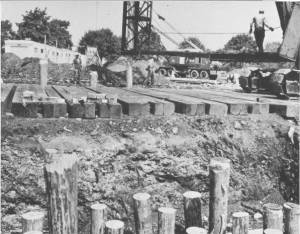 |
|
Building NYS
|
|
The first four 100-foot white concrete
columns for the Tent of Tomorrow are in place. There will be
sixteen in all for the host state's pavilion.
FAIR NEWS, December 20, 1962
|
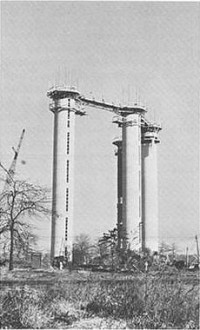 |
|
|
Columns as viewed from the Westinghouse
Site
Progress Report #7, January 24, 1963
|
 |
|
-
-
|
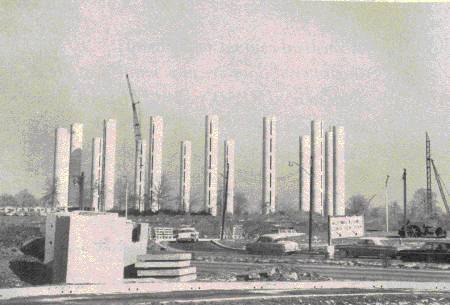
SLIDING FORMS MAKE REVOLUTIONARY BUILDING
METHODS POSSIBLE
|
|
The Nicholson Company, one of the nation's
leading engineer/contractor firms for almost 50 years, is used
to the unusual challenges presented by the architect's design
and the client's demands. And the New York State World's Fair
Pavilion designed by Philip Johnson is no exception. In each
of three stages, during the dead of winter, these mighty concrete
columns -- reaching 100 feet in height -- were continuously poured
in 5 days by the renowned Nicholson slip form method. The results:
16 attractively textured monolithic concrete structures.
Today Nicholson stands ready and able to
provide outstanding services to architects and owners designing
and building beautiful and utilitarian contemporary buildings.
Speed and economy is assured by utilizing Nicholson's specialized
techniques in the construction of the "cores" of high-rise
buildings for containment of all services, including elevatoring
and stairs.
For Nicholson there are no building problems
-- only building challenges.
|
-
THE NICHOLSON COMPANY
-
10 ROCKEFELLER PLAZA
-
NEW YORK 20, N. Y.
|
-
Source: Nicholson
Company advertisement
-
Source:
Architectural FORUM,
June, 1963, Vol. 118, No. 6
-
|
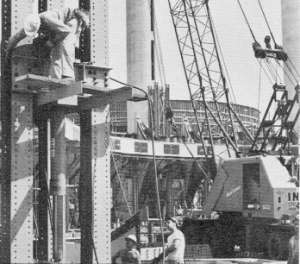 |
Interior Construction on New York State
Progress Report #9, September 26, 1963
|
|
|
Aerial View of construction on New York
State
Progress Report #9, September 26, 1963
|
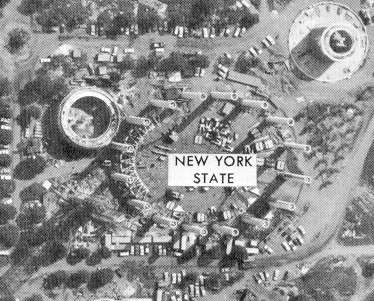 |
|
|
|
- CONSTRUCTION FACT
SHEET
- NEW YORK STATE EXHIBIT
- 1964-65 WORLD'S FAIR
|
|
PAVILION
The roof is supported
by cables suspended from a steel truss compression ring to a
steel tension ring in the center. The weight of the structural
steel is 2,000 tons.
The shape of the Pavilion
roof, steel truss, supporting columns, and promenade is an ellipse.
The major axis of the ellipse at the steel truss is 305' and
the minor axis is 225'.
There is an upper and
lower suspended cable system composed of 48 cables for each system.
The cable size varies from 1-11/16" to 2-1/4" diameter.
The compression ring
is supported on 16 needle beams cantilevered from 16 concrete
towers. Each tower is 98' high above the ground and was constructed
by the slipform system. The outside diameter of each tower is
12' and the walls are 1' thick. The pile cap for each tower is
supported on 50 wooden piles.
The roof is made of
1500 2-3/4" Kalwall structural plastic sandwich panels,
consisting of a top and bottom skin of fiberglass on an aluminum
grid system. The roof is translucent and is composed of 4 colors.
MEZZANINE
The promenade walkway
will be 15' above the ground. The outer perimeter is elliptical
in shape and the inner is a circle of 190' diameter.
There are 28 steel
bents supporting the steel framed deck. The deck is reinforced
concrete.
(continued)
|
|
|
OBSERVATION TOWERS
3 reinforced concrete
Observation Towers
|
Top of Steel |
| Height of tower No. 3
above ground |
226' |
| Height of tower No. 2
above ground |
181' |
| Height of tower No. 1
above ground |
85' |
Each tower has an outside
diameter of 12'-8" and the tower walls are 16" thick.
Structurally, the towers
are prestressed by means of the Stressteel post-tensioning system.
Each Observation Tower
platform is a steel platform 64' diameter suspended by cables
from overhead cantilevered girders.
The foundation for
the three towers is a large 7' thick pile cap supported by 207
steel pipe piles. The concrete work for the towers is by the
slipform system, accomplished in three increments. The rate of
slip is between 12" to 18" per hour.
The height of each
platform above the ground is:
| Platform No. 1 |
65' |
(Tower No. 1) |
| Platform No. 2 |
160' |
(Tower No. 2) |
| Platform No. 3 |
191' |
(Tower No. 3) |
| Platform No. 4 |
216' |
(Tower No. 3) |
THEATERAMA
| Outside Diameter |
100' |
| Height |
044' |
| Structure |
Reinforced Concrete |
| Finish |
Architectural Concrete |
| Vol. Concrete |
1,600 C.Y. |
| Roof |
Laminated Wood Roof |
| Piles |
445 |
| Partitions |
Concrete Block |
| Hung Ceiling - Basement |
Plaster |
| Hung Ceiling - Main Room |
1" Sprayed Acoustic
Asbestos |
| Circular (360o)
Picture Screen |
80' Diameter - 20' High |
| Wood Treatment |
Red Oak |
| Air Conditioned Theater |
|
|
|
|